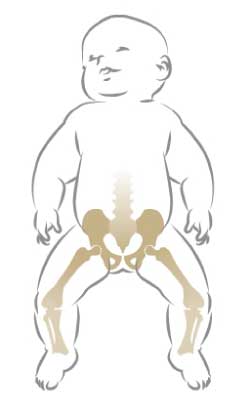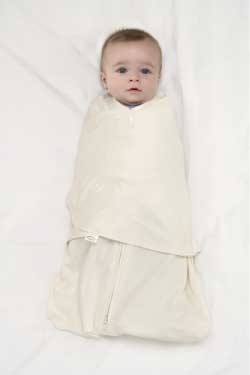 Bringing a newborn baby home from the hospital can be a sobering thing indeed, for there's so many immediate changes that take place and so much information parents have to learn quickly. Of course, all parents strive to be the absolute best parent they can, but sometimes we inadvertently harm our children because we're unaware of the latest research and developments when it comes to child rearing.
Bringing a newborn baby home from the hospital can be a sobering thing indeed, for there's so many immediate changes that take place and so much information parents have to learn quickly. Of course, all parents strive to be the absolute best parent they can, but sometimes we inadvertently harm our children because we're unaware of the latest research and developments when it comes to child rearing.
For instance, have you ever heard of hip dysplasia? I can honestly admit that I had not, but it's actually the most common abnormality among newborns. Hip dysplasia occurs when children are born with the hip out of socket or when the bones of the hip joint are not aligned correctly. This prevents the hip joint from functioning properly, thus causing the joint to wear out much faster.
When babies are checked for the condition at birth, about 2-3 babies per 1000 will require treatment. If caught early, it's easier to treat; however, many cases remain "hidden" until later in life when the patient experiences pain, early onset arthritis and even hip replacement. Keep reading to learn more!
If you have swaddled your baby tightly with the legs straight for extended periods of time, ask your pediatrician to carefully examine your child. When additional risk factors are present, then an ultrasound or x-ray may be considered.
 Risk factors for hip dysplasia
Risk factors for hip dysplasia
(These should cause parents and physicians to look more closely for possible hip dysplasia)
- Family history of hip dysplasia
- Breech position in the womb
- Prolonged or frequent tight swaddling with the legs straight
- Twisted neck or foot
- Birth weight more than 8 lbs 13 oz.
- Mother more than 35 years old
- Hip click
You can help your baby have healthy hips by recognizing risk factors, keeping your doctor appointments, and protecting your baby’s hips without swaddling the legs too tightly in the first few months of life.
What to look for in infants and children
Your pediatrician is trained in methods to examine a baby’s hips to detect hip dysplasia. When in doubt, ask him/her to check the hips carefully. Hip dysplasia does not cause pain or keep your baby from sitting, crawling, and walking at a normal age. Some findings that may alert you to possible hip dysplasia are:
- Uneven buttocks creases where one crease is higher than the other
- When changing diapers, one or both legs don’t spread out as fully as they should.
- A consistent clicking or bumping sensation when changing diapers
- One leg appears shorter than the other
- An extra crease is noticed on the inside of the thigh suggesting that the thigh is thicker and shorter than it should be. This is more noticeable if only one side is involved
- After walking age you may notice:
- Your child stands and walks with one foot on tiptoes with the heel off the floor (because of difference in leg lengths)
- Visible limping on one side
- If both sides are involved, there will be a waddling gait that is more exaggerated than a normal baby and excessive sway back posture in addition to the waddling gait.
 What to look for in teenagers and adults
What to look for in teenagers and adults
Hip dysplasia may be a cause of hip pain in adolescents and adults. Hip dysplasia means that the hip is not aligned properly in the socket. A person may have hip dysplasia and not have symptoms until the hip begins to wear out because the hip is not centered in the socket.
Only 10% of hip dysplasia cases can be detected in childhood by current methods of evaluation. This means that hidden hip dysplasia shows up after maturity in 90% of all hip dysplasia cases. For Caucasian women, hidden or unsuspected hip dysplasia is a common cause hip arthritis and pain.
The initial symptoms of hip dysplasia vary from person to person, but common complaints are:
- Groin pain or inguinal pain (deep ache in the front of the hip in the area of the hip crease)
- Generalized muscle fatigue around the hip after physical activities such as walking, hiking, or running
- Snapping or catching in the hip joint (not on the side of the thigh….see images on website)
- Initial pain may only be occasional or brought on by strenuous activities, but it worsens with time and with less strenuous activity
Medical tips:
- There are other causes of hip pain such as bursitis or hip impingement, but hip dysplasia should be evaluated and considered in all cases of hip pain
- The symptoms of hip dysplasia may be present for months or years before the correct diagnosis is made
- If hip pain persists for months without a clear diagnosis, evaluation by a doctor that is familiar with hip dysplasia may be worthwhile
- Mild forms of hip dysplasia may be difficult to diagnose with routine x-rays
- Treatment of hip dysplasia depends on the amount of arthritis already present in the hip. When treated early it is often possible to correct the alignment of the socket and relieve pain without waiting until the pain is so severe that a total hip replacement is needed
- Hip arthroscopy alone is rarely successful for hip dysplasia because that does not correct the alignment problem
- Weight loss and pain medications can be used for a short period of time, but the hip will continue to wear out unless the abnormal alignment is corrected with surgery
Many parents find that swaddling can provide comfort for fussy babies, reduce crying, and develop more settled sleep patterns. When babies are swaddled, care should be taken to swaddle properly so the baby is safe and healthy. There are many ways to swaddle babies by using blankets or commercial products designed for swaddling. In order for swaddling to allow healthy hip development, the legs should be able to bend up and out at the hips. This position allows for natural development of the hip joints.
The baby's legs should not be tightly wrapped straight down and pressed together. Swaddling infants with the hips and knees in an extended position may increase the risk of hip dysplasia and dislocation. For additional background information, please see the Official IHDI Position Statement on Hip-Healthy Swaddling.
 |
|
Disclosure: I received a HALO SleepSack 100% Cotton Swaddle in order to facilitate my review. No other compensation was received. This product review is based on my own personal experiences with this item and is completely honest and objective. |
I'm a former 7th grade Science teacher turned stay-at-home mom that lives in Houston, Texas. I am married to my college sweetheart and have a beautiful daughter named Riley, who definitely keeps me on my toes! I am also involved in starting a small business which would both manufacture and sell an invention that I've patented, called Toothpaste 2 Go. I love interacting with my readers and hope to learn as much about you as you learn about me!
Melissa @ Mommy Living the Life of Riley!
Add Melissa Cleaver to your LinkedIn Network
Add Mommy Living the Life of Riley to your Google+ circle |









